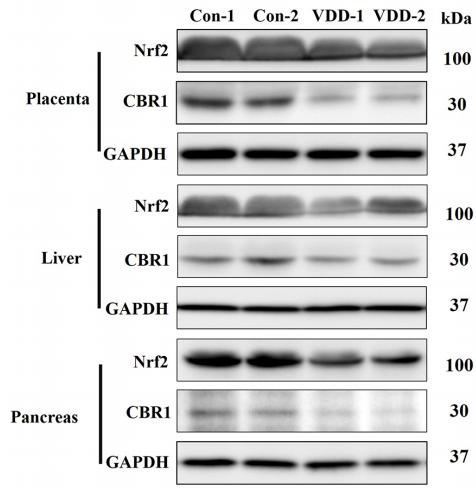CBR1 Antibody - #DF3893
| Product: | CBR1 Antibody |
| Catalog: | DF3893 |
| Description: | Rabbit polyclonal antibody to CBR1 |
| Application: | WB IHC IF/ICC |
| Cited expt.: | WB |
| Reactivity: | Human, Mouse |
| Prediction: | Chicken |
| Mol.Wt.: | 32 KD; 30kD(Calculated). |
| Uniprot: | P16152 |
| RRID: | AB_2836246 |
Product Info
*The optimal dilutions should be determined by the end user. For optimal experimental results, antibody reuse is not recommended.
*Tips:
WB: For western blot detection of denatured protein samples. IHC: For immunohistochemical detection of paraffin sections (IHC-p) or frozen sections (IHC-f) of tissue samples. IF/ICC: For immunofluorescence detection of cell samples. ELISA(peptide): For ELISA detection of antigenic peptide.
Cite Format: Affinity Biosciences Cat# DF3893, RRID:AB_2836246.
Fold/Unfold
15 hydroxyprostaglandin dehydrogenase [NADP+]; 15-hydroxyprostaglandin dehydrogenase [NADP+]; Carbonyl reductase [NADPH] 1; Carbonyl Reductase 1; CBR 1; CBR1; CBR1_HUMAN; CRN; NADPH dependent carbonyl reductase 1; NADPH-dependent carbonyl reductase 1; Prostaglandin 9 ketoreductase; Prostaglandin 9-ketoreductase; Prostaglandin E(2) 9 reductase; Prostaglandin-E(2) 9-reductase; SDR21C1;
Immunogens
A synthesized peptide derived from human CBR1, corresponding to a region within C-terminal amino acids.
- P16152 CBR1_HUMAN:
- Protein BLAST With
- NCBI/
- ExPASy/
- Uniprot
MSSGIHVALVTGGNKGIGLAIVRDLCRLFSGDVVLTARDVTRGQAAVQQLQAEGLSPRFHQLDIDDLQSIRALRDFLRKEYGGLDVLVNNAGIAFKVADPTPFHIQAEVTMKTNFFGTRDVCTELLPLIKPQGRVVNVSSIMSVRALKSCSPELQQKFRSETITEEELVGLMNKFVEDTKKGVHQKEGWPSSAYGVTKIGVTVLSRIHARKLSEQRKGDKILLNACCPGWVRTDMAGPKATKSPEEGAETPVYLALLPPDAEGPHGQFVSEKRVEQW
Predictions
Score>80(red) has high confidence and is suggested to be used for WB detection. *The prediction model is mainly based on the alignment of immunogen sequences, the results are for reference only, not as the basis of quality assurance.
High(score>80) Medium(80>score>50) Low(score<50) No confidence
Research Backgrounds
NADPH-dependent reductase with broad substrate specificity. Catalyzes the reduction of a wide variety of carbonyl compounds including quinones, prostaglandins, menadione, plus various xenobiotics. Catalyzes the reduction of the antitumor anthracyclines doxorubicin and daunorubicin to the cardiotoxic compounds doxorubicinol and daunorubicinol. Can convert prostaglandin E2 to prostaglandin F2-alpha. Can bind glutathione, which explains its higher affinity for glutathione-conjugated substrates. Catalyzes the reduction of S-nitrosoglutathione.
Cytoplasm.
Belongs to the short-chain dehydrogenases/reductases (SDR) family.
Research Fields
· Human Diseases > Cancers: Overview > Chemical carcinogenesis.
· Metabolism > Lipid metabolism > Arachidonic acid metabolism.
· Metabolism > Metabolism of cofactors and vitamins > Folate biosynthesis.
· Metabolism > Xenobiotics biodegradation and metabolism > Metabolism of xenobiotics by cytochrome P450.
· Metabolism > Global and overview maps > Metabolic pathways.
References
Application: WB Species: human Sample: maternal placenta, liver, and pancreas
Restrictive clause
Affinity Biosciences tests all products strictly. Citations are provided as a resource for additional applications that have not been validated by Affinity Biosciences. Please choose the appropriate format for each application and consult Materials and Methods sections for additional details about the use of any product in these publications.
For Research Use Only.
Not for use in diagnostic or therapeutic procedures. Not for resale. Not for distribution without written consent. Affinity Biosciences will not be held responsible for patent infringement or other violations that may occur with the use of our products. Affinity Biosciences, Affinity Biosciences Logo and all other trademarks are the property of Affinity Biosciences LTD.
